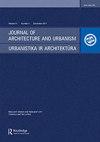第16届威尼斯建筑双年展宣言的批评性话语分析
IF 0.8
0 ARCHITECTURE
引用次数: 0
摘要
威尼斯建筑双年展在20世纪70年代末和80年代初以后现代思想出现。它是建筑领域经历政治、经济和文化变革的媒介,也是讨论和分享全球主流建筑的媒介。随着时间的推移,威尼斯建筑双年展创造了一个全球焦点的宣言,同时在当地建筑边界的模糊中汇集了建筑产品和思想。双年展宣言具有面向建筑领域社会关系的意识形态结构。纵观最近的威尼斯建筑双年展,可以说,知识生产是发展批判性思维的话语和产品的最前沿。在此背景下,本研究涉及第16届威尼斯建筑双年展的宣言。2018年的宣言是在双年展范围内制作的;策展人的意识形态有其主观和客观的判断,值得审视。为此,本研究采用Norman Fairclough的批评性话语分析(CDA)对两年期宣言进行批判性解读。利用批评性话语分析的特点,在意识形态、话语解释和话语一致性三个方面得出了研究结果和结论。由于分析的性质,研究结果和结论揭示了一个在该领域有争议的新话语。本文章由计算机程序翻译,如有差异,请以英文原文为准。
CRITICAL DISCOURSE ANALYSIS (CDA) OF THE 16TH VENICE ARCHITECTURE BIENNALE MANIFESTO
The Venice Architecture Biennale emerged with post-modern thought in the late 1970s and early 1980s. It is a medium where political, economic and cultural transformations are experienced in the field of architecture and where mainstream global architecture is discussed and shared. Over time, the Venice Architecture Biennale has created a global focal point with the manifestos produced, while bringing together the architectural products and ideas in the ambiguity of the boundaries of local architecture. Biennial manifestos have an ideological structure that is oriented towards social relations in the field of architecture. Looking at the recent Venice Architecture Biennale, it can be said that knowledge production is at the forefront in discourses and products which develops critical thinking. In this context, the study deals with the manifesto1 of the 16th Venice Architecture Biennale. The 2018’s manifesto which was produced within the scope of the biennial; the curator’s ideology is worth examining because of its subjective and objective judgments. For this reason, Norman Fairclough’s critical discourse analysis (CDA) was used in the study to make a critical reading of the biennial manifestos. By using the characteristics of CDA, findings and conclusions were reached in the topics of ideology, interpretation and consistency of the discourse. Due to the nature of the analysis, the findings and conclusions have revealed a new discourse that is controversial in this field.
求助全文
通过发布文献求助,成功后即可免费获取论文全文。
去求助
来源期刊

Journal of Architecture and Urbanism
ARCHITECTURE-
CiteScore
1.30
自引率
14.30%
发文量
12
审稿时长
15 weeks
期刊介绍:
The Journal of Architecture and Urbanism publishes original research on all aspects of urban architecture.
 求助内容:
求助内容: 应助结果提醒方式:
应助结果提醒方式:


